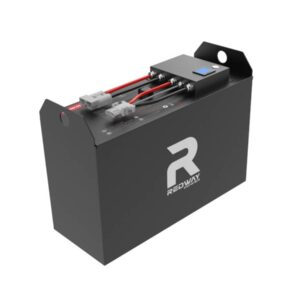How do I get more life out of my lithium battery?
Maximize lithium battery lifespan by maintaining charge levels between 20-80%, avoiding extreme temperatures, and using manufacturer-approved chargers. Partial charging cycles reduce electrolyte stress, while storing at 40-60% charge in cool environments (15-25°C) minimizes calendar aging. Implement Battery Management System (BMS) calibration quarterly to ensure accurate state-of-charge readings, and prioritize balanced cell voltages during charging.
How to Maximize Forklift Battery Lifespan
Why does partial charging extend lithium battery life?
Partial charging (20-80%) reduces lithium plating and cathode stress. Full 0-100% cycles accelerate solid electrolyte interface (SEI) layer growth, permanently reducing capacity. Pro Tip: Set charger cutoff at 4.0V/cell instead of 4.2V to gain 2-4x more cycles with 10-15% capacity tradeoff.

Lithium-ion batteries experience mechanical strain during deep discharges and high-voltage charges. When you consistently charge to 100%, the cathode’s layered structure expands, creating micro-cracks that reduce ionic conductivity. Think of it like repeatedly stretching a rubber band until it loses elasticity. For example, EV manufacturers like Tesla recommend daily charging to 80%—this practice can extend pack life beyond 300,000 miles. But what if you occasionally need full capacity? Monthly full cycles help BMS recalibrate capacity estimates without significant degradation. Always prioritize shallow discharge cycles (30-50% depth) for high-use devices.
How do temperatures impact lithium battery longevity?
Heat above 30°C doubles chemical degradation rates, while sub-zero temperatures induce metallic lithium plating during charging. Store batteries at 15-25°C for optimal shelf life.
Elevated temperatures accelerate parasitic reactions between the electrolyte and anode. At 40°C, a lithium battery loses 35% more capacity per year compared to 25°C storage—even when unused. Cold environments aren’t safer either. Charging below 0°C causes lithium ions to plate rather than intercalate into graphite, creating dendrites that risk internal shorts. Imagine trying to pour thick syrup into narrow tubes; that’s how ions behave in freezing conditions. Pro Tip: Use thermal management systems in EVs/power tools, and never charge a battery that feels warm to the touch. A 10°C reduction in operating temperature can triple cycle life for high-drain applications.
| Temperature | Capacity Loss/Year | Safe Charging? |
|---|---|---|
| 45°C | 40% | No |
| 25°C | 20% | Yes |
| 0°C | 5% | Below 0.2C rate |
What storage practices preserve lithium batteries?
Store at 40-60% charge in climate-controlled environments. Full-charged batteries lose 8-20% capacity monthly versus 2-5% at partial charge due to electrolyte decomposition.
Lithium batteries enter a “sleep mode” when stored at 3.6-3.8V/cell (≈50% SoC), minimizing side reactions. The Army’s battery preservation protocol mandates 15°C storage at 40% charge for 10-year readiness. Practically speaking, if you’re storing an electric bike over winter, charge it to 60% first and disconnect the BMS to prevent parasitic drain. But how does humidity factor in? While lithium cells are sealed, terminals can corrode in humid environments—use silica gel packs in storage containers. Always recharge stored batteries to 50% every 6 months to prevent deep discharge.
Do charging habits affect battery lifespan?
Fast charging (above 1C rate) generates heat and mechanical stress, reducing cycle life by 10-30%. Use slow overnight charging for daily maintenance, reserving fast charging for emergencies.
DC fast chargers force lithium ions through the electrolyte at accelerated rates, causing localized heating that degrades binder materials in electrodes. A study on NCA cells showed 500 cycles at 1C versus 1,200 cycles at 0.5C charging. It’s like sprinting versus jogging—the latter is sustainable long-term. Pro Tip: If using fast charging, keep battery temperature below 35°C with cooling systems. Electric vehicles mitigate this with liquid-cooled packs, but phones/laptops lack such luxury—avoid gaming while fast charging.
| Charging Rate | Cycle Life | Time to 80% |
|---|---|---|
| 0.5C | 1,500 | 2 hours |
| 1C | 800 | 1 hour |
| 2C | 400 | 30 minutes |
Forklift Battery Maintenance Checklist Essentials
Battery Expert Insight
FAQs
Should I charge my phone overnight?
Modern devices stop charging at 100%, but keeping them plugged in maintains high voltage stress. Use smart plugs to charge to 80% before waking.
Can a “dead” lithium battery be revived?
If voltage stays below 2.5V/cell for weeks, permanent copper dissolution occurs. Recovery attempts risk fire—replace instead.
Do third-party chargers damage batteries?
Non-OEM chargers often lack proper voltage regulation and temperature sensing. A $5 charger could cost $150 in premature battery replacement.
